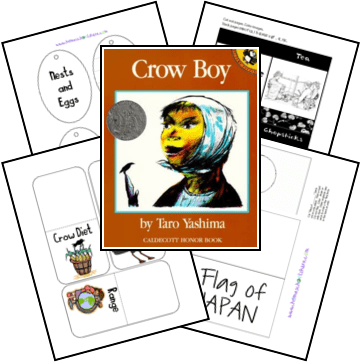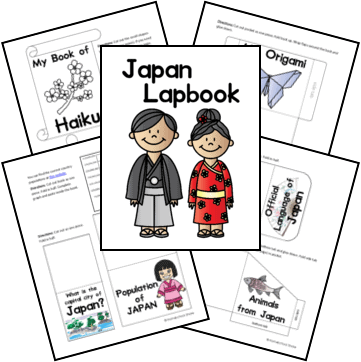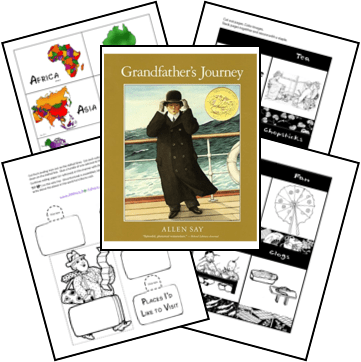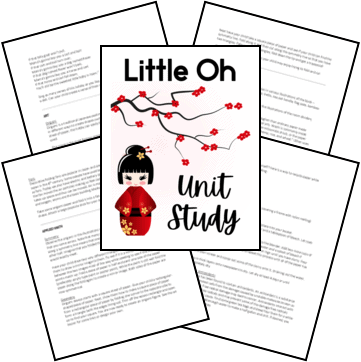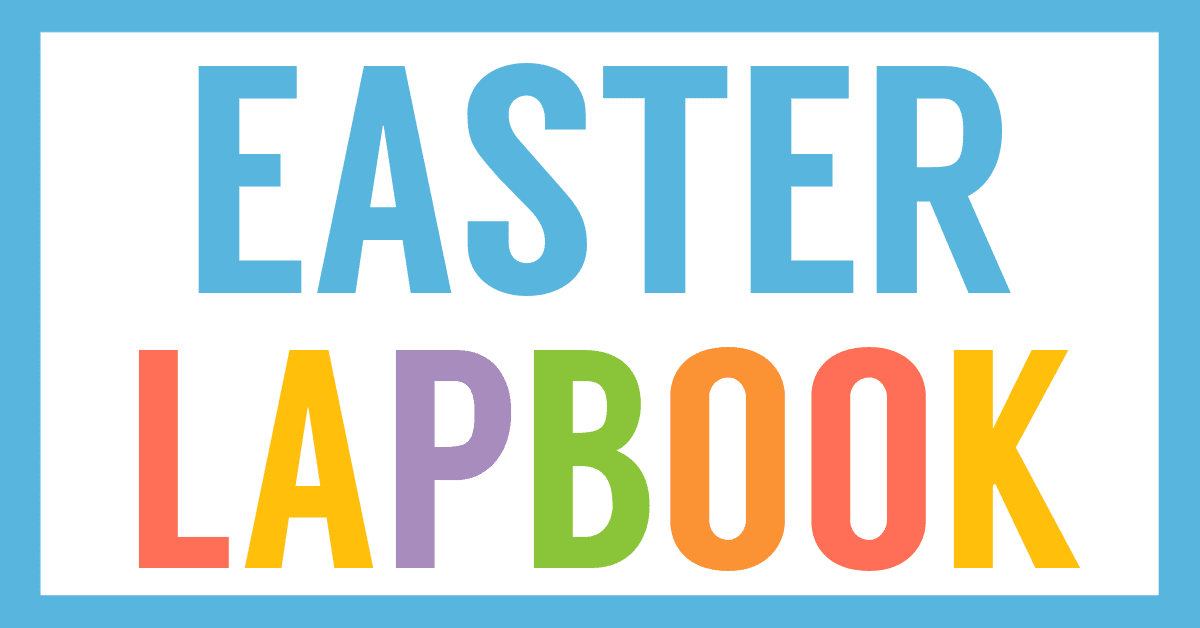Affiliate Disclaimer
We sometimes use affiliate links in our content. This won’t cost you anything, but it helps us to keep the site running. Thanks for your support.
A shy Japanese boy having difficulty adjusting to school is misjudged by his classmates. Chibi has been an outcast since that frightening first day of school when he hid under the schoolhouse. Afraid of the teacher and unable to make any friends, Chibi passes his free time alone — alone at study time, alone at playtime, always a “forlorn little tag-along.” But when Mr. Isobe arrives, the teacher sees things in Chibi that no one else has ever noticed.
from the Crow Boy summary at amazon.com
Grab our free Crow Boy unit study and lapbook and explore lessons about Japan, Japanese culture, human relationships, crows, illustrations, wood block prints, and more.
Thanks to Casey Kelley for writing the lessons for this Crow Boy unit study.
Crow Boy Unit Study Lessons
This unit study includes lessons and printables based on the book Crow Boy by Taro Yashima.
Here are some sample lessons from the Crow Boy Unit Study:
Geography: Japan
The name Japan means “the sun” and Japan is also referred to as “the land of the rising sun.” The Japanese flag is a red circle (sun) on a white background. Have students use red and white construction paper to make a Japanese flag.
The country of Japan is made up of over three thousand islands. Many of these islands are mountainous and some are volcanic. Japan’s highest peak is a volcano called Mount Fuji. Have your students research how islands are formed.
In the book, Crow Boy the story takes place in a village in Japan. A village is a small community of perhaps 5 to 30 families that settled in a rural area. In Japan, villages are often farm or fishing communities. Your older students can research Japanese villages and create their own on paper.
Even though Japan is relatively short on real estate, it has the world’s tenth largest population with about 128 million people.
Japanese Artist Study
Katsushika Hokusai lived September 23, 1760 until April 18, 1849. He was a Japanese painter and printmaker from the Edo Period and is most famous for his series of woodblock prints called “Thirty-Six Views of Mount Fuji”. One of the views, “The Great Wave Off Kanagawa,” has become most popular and is studied by art students all over the world.
Hokusai was born in what is now called Tokyo, Japan. During his life, Hokusai produced tens of thousands of prints, paintings, and illustrations. Hokusai’s themes were usually the Japanese countryside, the people and legends. Many years later, Hokusai’s prints influenced other great artist like van Gogh, Monet, Degas, and Toulouse-Lautrec.
Science: Crows
Discuss the following information with your student. You may also want to check out some library books about crows. Be sure to watch the video clips below as your student will really get an understanding for just how smart this bird is!
Anatomy:
Crows comprise the genus Corus. These birds are usually black with black beaks and black legs, some have white, brown, or gray coloring in addition to their black. The common crow is approximately 8-12 inches long.
Diet:
Crows will eat just about anything (they are omnivorous eating plants and animals). Their diets include worms, insects, road kill, mice, berries, crops, (especially corn), the eggs of other birds, and anything else they can find (even fast-food!). An adult crow needs 11 ounces of food each day. Despite their bad reputation for eating crops, crows also eat a number of pests which are harmful to those same crops, including cutworms, wireworms, grasshoppers and even noxious weeds.
Range:
The 40 some members of this genus can be found just about anywhere in the world (except Antarctica, New Zealand, and South America). They thrive in mountains, woodlands, across plains and farmers’ fields, and throughout urban areas.
Nesting Habits
Crows build bulky nests out of twigs and line them with bark, grass, and/or small roots. The female lays the eggs in the nest (usually 4-7) and the male helps with the incubation. Once the eggs hatch, the baby birds remain in the nest for 6-8 weeks while their parents bring them food.
Intelligence:
Crows (and ravens) may be the most intelligent of all birds.
You can grab a copy of the entire Crow Boy Unit Study and Lapbook in an easy-to-print file at the end of this post.
Crow Boy Lapbook Printables
In addition to the lessons, this Crow Boy unit study includes the following mini-books for your student’s lapbook:
- Japanese Culture Mini-book
- Where in the World Is Japan? Shutterfold
- Flag of Japan Simple Fold
- “The Crow and the Pitcher” Notebook Page with Mini-books
- Crow Diet Simple Fold
- Crow Intelligence Simple Fold
- Crow Range Simple Fold
- Nests & Eggs Egg Shape Book
- Crow Anatomy Flap Book
How to Get Started with Your Crow Boy Unit Study & Lapbook
Follow these simple instructions to get started with the Crow Boy Unit Study:
- Buy a copy of the book, Crow Boy, or borrow one from your local library.
- Print the Crow Boy unit study.
- Choose the lessons you want to use with your student (a highlighter works great for this).
- Choose and prepare the lapbook printables you want to use with your student.
- Enjoy a week of learning with Crow Boy.
Get Your Free Crow Boy Unit Study & Lapbook
Simply click on the image below to access your free Crow Boy Unit Study and Lapbook.

